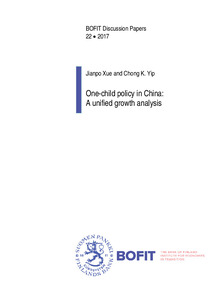One-child policy in China : A unified growth analysis
Xue, Jianpo; Yip, Chong K. (29.12.2017)
Numero
22/2017Julkaisija
Bank of Finland
2017
Julkaisun pysyvä osoite on
https://urn.fi/URN:NBN:fi:bof-201801081010Tiivistelmä
This paper examines the effects of China's One Child Policy (OCP) in a stylized unified growth model where demographic change plays a central role. Introducing a population constraint into Galor and Weil (2000) model, our theoretical analysis shows that parents are willing to invest in the education of their children immediately after the OCP intervention. Raising the education level, in turn, boosts rates of technological progress and economic growth over the short run, but the low population mass resulting from the OCP hampers the natural economic evolution. This eventually reduces the education gain and technology growth, retarding economic growth in the steady state. We next calibrate our model to match the key data moments in China. A permanent OCP is found to accelerate economic growth by up to 60% over the short run (40 years, or two generations under our assumed generation length), but depress long-run growth to 6:95% (8:94% under natural evolution). For a temporary OCP lifted after two generations, the economic growth shows an immediate decline of about 27%, followed by a gradual recovery to the steady state under natural evolution. While the OCP reduces welfare, the welfare loss from a temporary OCP is less than that from a permanent OCP. This suggests that the recent decision of the Chinese government to abandon the OCP and move to a two-child policy is likely to improve economic growth and welfare over the long run.
